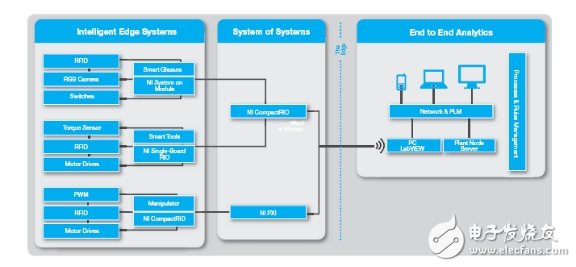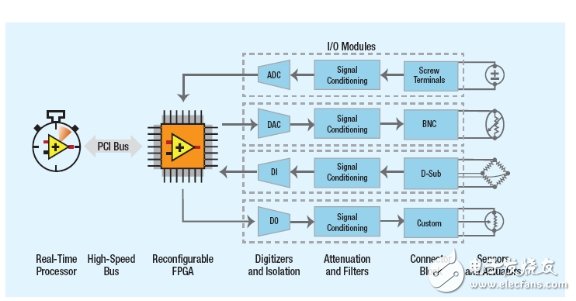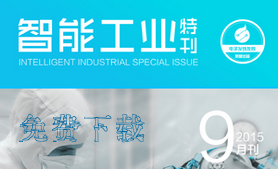Over the past decade, our society has become increasingly dependent on the latest in electronics and communication technologies, from mobile devices to smart vehicles to home automation. The Internet of Things (IoT) is formed by embedding these items or "objects" in electronics, software, and sensors and connecting them together using connection technology. The concept of the Internet of Things was proposed by technology pioneer Kevin Ashton in 1999, referring to the development of connectivity technologies between people, machines and infrastructure that will enhance intelligence, business insight, efficiency and innovation.

Figure 1 - The three basic pillars of intelligent systems and the Internet of Things: intelligent edge systems, individual systems in multiple systems, and end-to-end analysis. Devices will become smarter and defined by software.
IoT has great potential and will have a profound impact on our lives. National Instruments customers play a key role in developing, deploying and optimizing core components of the IoT, such as consumer/industrial products and systems, and the wired and wireless infrastructure that connects these products to systems.
National Instruments and Xilinx's more than ten years of technical cooperation have launched a number of powerful tools to help engineers and researchers to innovate and reshape the world. From NI FlexRIO modules to CompactRIO controllers, as well as NI system-on-a-system (SoM) and myRIO devices, National Instruments has adopted Xilinx's latest generations of devices in its most advanced generations. National Instruments is proud to help innovators use the integrated hardware and software platform to design, build and test these intelligent devices.
The challenges facing the Internet of Things
According to data provided by Gartner, an estimated 4.9 billion connected devices will be put into use in 2015 and will increase to 25 billion by 2020. These networked systems range from mechanical equipment in smart factories, advanced driver assistance systems (ADAS) in cars, to power grids in smart cities, and health-care wearables that help to prolong life. The characteristics of the Industrial Internet of Things can be described as a large number of networked industrial systems that communicate with each other, coordinate data analysis and behavior to enhance industrial performance and benefit the entire society.

Figure 2 - NI LabVIEW's reconfigurable I/O (RIO) architecture is based on four components: processors, reconfigurable FPGAs, modular I/O hardware, and graphics design software.
The industrial system that connects the digital world to the physical world by solving complex control problems through sensors and actuators is the information physics system commonly known. These systems are combining Big Analog Data solutions with deeper information through data and analysis. Imagine that industrial systems can adjust their own environment and even their own health. Mechanical equipment does not always use failures, but schedules its own maintenance work, even dynamically adjusting its own control algorithms to compensate for worn parts, and then notifies the data to other machines and operators who use them.
Based on this, the Internet of Things field shown in Figure 1 can be further subdivided into three parts: smart edge (sensor/actuator), System of Systems (SoS), and meeting the requirements of delay, synchronization and reliability. Supports end-to-end analysis of all connectivity and data analysis. Typically, these smart products are manufactured by different vendors, so the embedded processors, protocols, and software used are different. Product integration throughout the design cycle through the final deployment process is a key challenge. A fully networked world requires a platform-based approach.
Platform-based design
The platform-based design concept stems from formal modeling techniques, clearly defined levels of abstraction, and separation of concerns to achieve an effective design process. All of these factors are critical to designing and building an IoT system. It is designed to provide engineers with the right level of abstraction and connectivity to other components and subsystems that use different software languages ​​(or frameworks) and different hardware protocols. Over the past four decades, National Instruments has provided a number of powerful and flexible technology solutions that empower engineers and researchers to increase productivity, innovation and development capabilities. National Instruments invests heavily in the development of integrated software and hardware platforms to help customers in the healthcare, automotive, consumer electronics, particle physics and other fields reduce design complexity.
Specifically, the NI LabVIEW Reconfigurable I/O (RIO) architecture shown in Figure 2 takes advantage of open LabVIEW software and commercial off-the-shelf (COTS) hardware to provide a common architecture for designing and building IoT systems. LabVIEW RIO has recently reintegrated the Xilinx Zynq®-7000 All Programmable SoC platform. This will continue to promote openness and scalability by introducing the Linux Real-Time Operating System (RTOS) and creating platforms that cover both academia and industry with the same chipset. Combining the LabVIEW RIO architecture with technologies such as NI DIAdem and NI InsightCM for data management and data aggregation, customers can design, build, and test IoT devices throughout the product design cycle, using common platforms and architectures for preventative maintenance.
This article is selected from the electronic enthusiast "Intelligent Industry Special", more quality content, download now


Wifi Led Grow Light,Led Grow Light With Wifi Control,Wifi Led Grow Light Wholesale,Wifi Led Square Grow Light Panel
Shenzhen Mingxue Optoelectronics CO.,Ltd , https://www.led-lamp-china.com